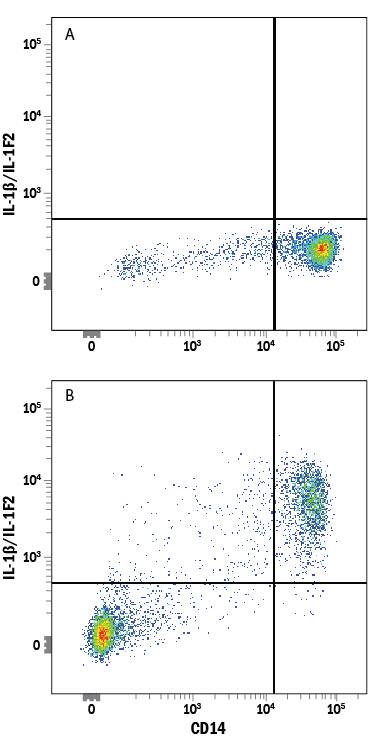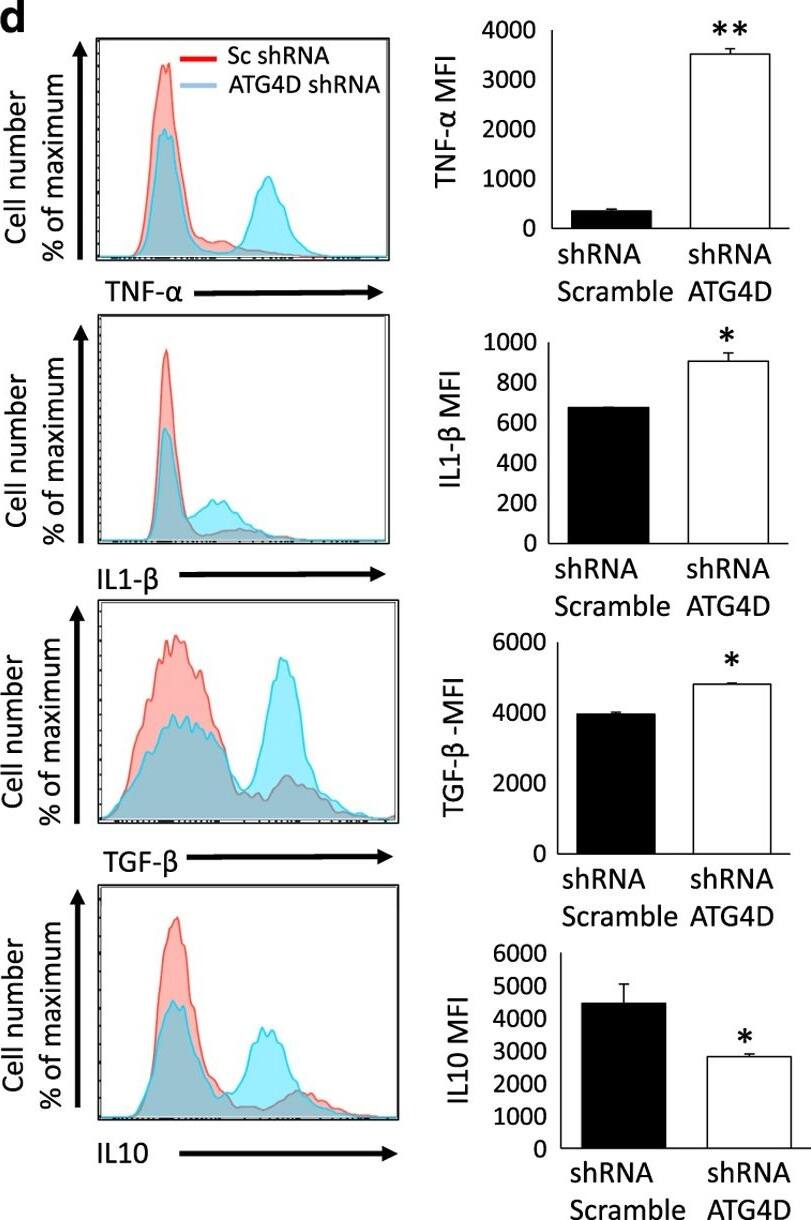Human IL-1 beta/IL-1F2 APC-conjugated Antibody
R&D Systems, part of Bio-Techne | Catalog # IC8406A
Recombinant Monoclonal Antibody.


Conjugate
Catalog #
Key Product Details
Validated by
Knockout/Knockdown, Biological Validation
Species Reactivity
Human
Applications
Intracellular Staining by Flow Cytometry
Label
Allophycocyanin (Excitation = 620-650 nm, Emission = 660-670 nm)
Antibody Source
Recombinant Monoclonal Rabbit IgG Clone # 1027B
Product Specifications
Immunogen
E. coli-derived recombinant human IL‑1 beta/IL‑1F2
Ala117-Ser269
Accession # P01584
Ala117-Ser269
Accession # P01584
Specificity
Detects human IL‑1 beta/IL‑1F2 by direct ELISAs.
Clonality
Monoclonal
Host
Rabbit
Isotype
IgG
Scientific Data Images for Human IL-1 beta/IL-1F2 APC-conjugated Antibody
Detection of IL‑1 beta/IL‑1F2 in Human Blood Monocytes by Flow Cytometry.
Human peripheral blood monocytes either (A) untreated or (B) treated with 250 ng/mL LPS overnight were stained with Rabbit Anti-Human IL-1 beta/IL-1F2 APC-conjugated Monoclonal Antibody (Catalog # IC8406A) and Mouse Anti-Human CD14 PE-conjugated Monoclonal Antibody (Catalog # FAB3832P). Quadrant markers were set based on control antibody staining (Catalog # IC105A). To facilitate intracellular staining, cells were fixed with Flow Cytometry Fixation Buffer (Catalog # FC004) and permeabilized with Flow Cytometry Permeabilization/Wash Buffer I (Catalog # FC005). View our protocol for Staining Intracellular Molecules.Detection of Human IL-1 beta/IL-1F2 by Flow Cytometry
Knock-down of ATG4D by shRNA in UTSM cell line mimic UF phenotype. (a) Autophagy markers analysis by FACS with intracellular staining and mean fluorescence intensity MFI for LC3, and (b) by western blot for LC3 and P62. (c) Extracellular matrix markers analysis by western blot. (d) Endogenous quantification of pro-inflammatory cytokines expression was done by intracellular staining for TNF-alpha, IL-1 beta, TGF-beta and IL-10 using flow cytometry analysis. The expression level was represented as mean fluorescence intensity (MFI). Data from the histogram are shown as mean±S.D. and are representative of three independent experiments. *P<0.05, **P<0.01, ***P<0.001. Image collected and cropped by CiteAb from the following publication (https://www.nature.com/articles/cddiscovery201741), licensed under a CC-BY license. Not internally tested by R&D Systems.Applications for Human IL-1 beta/IL-1F2 APC-conjugated Antibody
Application
Recommended Usage
Intracellular Staining by Flow Cytometry
10 µL/106 cells
Sample: Human peripheral blood monocytes treated with LPS were fixed with Flow Cytometry Fixation Buffer (Catalog # FC004) and permeabilized with Flow Cytometry Permeabilization/Wash Buffer I (Catalog # FC005)
Sample: Human peripheral blood monocytes treated with LPS were fixed with Flow Cytometry Fixation Buffer (Catalog # FC004) and permeabilized with Flow Cytometry Permeabilization/Wash Buffer I (Catalog # FC005)
Reviewed Applications
Read 1 review rated 4 using IC8406A in the following applications:
Formulation, Preparation, and Storage
Purification
Protein A or G purified from cell culture supernatant
Formulation
Supplied in a saline solution containing BSA and Sodium Azide.
Shipping
The product is shipped with polar packs. Upon receipt, store it immediately at the temperature recommended below.
Stability & Storage
Protect from light. Do not freeze.
- 12 months from date of receipt, 2 to 8 °C as supplied.
Background: IL-1 beta/IL-1F2
Long Name
Interleukin 1 beta
Alternate Names
IL-1b, IL-1F2, IL1 beta, IL1B
Entrez Gene IDs
Gene Symbol
IL1B
UniProt
Additional IL-1 beta/IL-1F2 Products
Product Documents for Human IL-1 beta/IL-1F2 APC-conjugated Antibody
Product Specific Notices for Human IL-1 beta/IL-1F2 APC-conjugated Antibody
For research use only
